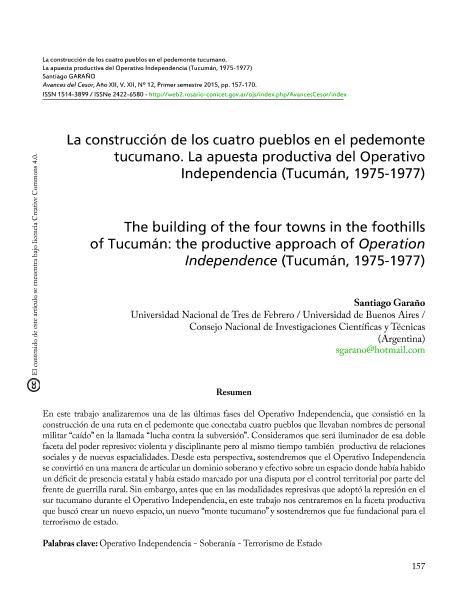Mostrar el registro sencillo del ítem
dc.contributor.author
Garaño, Santiago

dc.date.available
2018-08-29T20:10:03Z
dc.date.issued
2015-08
dc.identifier.citation
Garaño, Santiago; La construcción de los cuatro pueblos en el pedemonte. La apuesta productiva del Operativo Independencia (Tucumán, 1975-1977); Universidad Nacional de Rosario. Investigaciones Socio-históricas Regionales; Avances del Cesor; XII; 12; 8-2015; 157-170
dc.identifier.issn
1514-3899
dc.identifier.uri
http://hdl.handle.net/11336/57587
dc.description.abstract
En este trabajo analizaremos una de las últimas fases del Operativo Independencia, que consistió en la construcción de una ruta en el pedemonte que conectaba cuatro pueblos que llevaban nombres de personal militar “caído” en la llamada “lucha contra la subversión”. Consideramos que será iluminador de esa doble faceta del poder represivo: violenta y disciplinante pero al mismo tiempo también productiva de relaciones sociales y de nuevas espacialidades. Desde esta perspectiva, sostendremos que el Operativo Independencia se convirtió en una manera de articular un dominio soberano y efectivo sobre un espacio donde había habido un déficit de presencia estatal y había estado marcado por una disputa por el control territorial por parte del frente de guerrilla rural. Sin embargo, antes que en las modalidades represivas que adoptó la represión en el sur tucumano durante el Operativo Independencia, en este trabajo nos centraremos en la faceta productiva que buscó crear un nuevo espacio, un nuevo “monte tucumano” y sostendremos que fue fundacional para el terrorismo de estado.
dc.description.abstract
In this essay we will analyse the last stages of “Operation Independence”, which consisted in the building of a road that linked four towns named after military personnel killed in the so-called “fight against subversion”, in the foothills of Tucumán. The case sheds some light over the twofold nature of repressive power: not only violent and disciplinary but also productive of new social relationships and new spatial changes in the area of the Tucuman hills. From this perspective, we argue that Operation Independence became a way to articulate an effective and sovereign domain over an area that lacked state presence, signed by a dispute with rural guerrillas over land control. However, this article does not focus on the forms of repression used in the south of Tucuman during Operation Independence. Rather, it pays particular attention to the productive aspects that aimed to create a new order in the Tucuman hills, which had paramount importance for state terrorism.
dc.format
application/pdf
dc.language.iso
spa
dc.publisher
Universidad Nacional de Rosario. Investigaciones Socio-históricas Regionales
dc.rights
info:eu-repo/semantics/openAccess
dc.rights.uri
https://creativecommons.org/licenses/by-nc-sa/2.5/ar/
dc.subject
Operativo Independencia
dc.subject
Soberania
dc.subject
Terrorismo de Estado
dc.subject.classification
Otras Sociología

dc.subject.classification
Sociología

dc.subject.classification
CIENCIAS SOCIALES

dc.title
La construcción de los cuatro pueblos en el pedemonte. La apuesta productiva del Operativo Independencia (Tucumán, 1975-1977)
dc.title
The building of the four towns in the foothills of Tucumán: the productive approach of Operation Independence (Tucumán, 1975-1977)
dc.type
info:eu-repo/semantics/article
dc.type
info:ar-repo/semantics/artículo
dc.type
info:eu-repo/semantics/publishedVersion
dc.date.updated
2018-08-29T14:32:35Z
dc.journal.volume
XII
dc.journal.number
12
dc.journal.pagination
157-170
dc.journal.pais
Argentina

dc.journal.ciudad
Rosario
dc.description.fil
Fil: Garaño, Santiago. Consejo Nacional de Investigaciones Científicas y Técnicas; Argentina. Universidad Nacional de Tres de Febrero; Argentina. Universidad de Buenos Aires; Argentina
dc.journal.title
Avances del Cesor
dc.relation.alternativeid
info:eu-repo/semantics/altIdentifier/url/http://web2.rosario-conicet.gov.ar/ojs/index.php/AvancesCesor/article/view/v12n12a09
Archivos asociados
